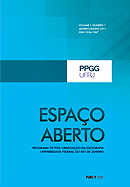The Application of Geochronometric Techniques in Geomorphology: a methodological updating
DOI:
https://doi.org/10.36403/espacoaberto.2016.5238Keywords:
Geochronology, Absolute Dating, Radiometric DatingAbstract
The emergence of geomorphology as an academic systematized discipline at the end of the 19th Century, was marked by an attempt to explain landform-shaping processes based on the identification of alleged temporal evolutionary stages of the earth's relief. Thus, denudation chronology, in davisian sense, became the first methodology aimed at attributing relative age to landforms, based on lithostratigraphic approaches and spatial analysis of land morphologies. Following the appearance and diffusion, after the second half of the 20th Century, of absolute dating methods, mostly radiometric, researchers started to count with a valuable resource to propose more realistic reconstructions of geomorphic events. From radiocarbon to luminescence and cosmogenic isotopes techniques, geomorphological dating methods cover a vast range of time scales, and can be applied to several types of landforms and materials. Nonetheless, as important as understanding the application of each of the techniques, It is capital to grasp their limitations as far as usage and results interpretation are concerned. At last, in spite of the limitations inherent to any temporal reconstruction of aggradation or denudation landforms, the application of geochronometric techniques has brought about fundamental advances in the level of accuracy and interpretative quality of landform reconstruction schemes, which help reformulate landscape evolution models.



